The Rise and Fall of Mentone Pier
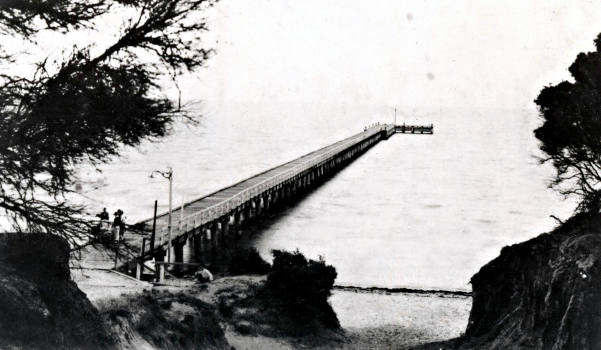
The Mentone Pier and cliffs, c1920. Courtesy Mordialloc and District Historical Society.
Piers, or jetties as they were often called, took pride of place at many beach locations a century or more ago. The British people who established Melbourne during the nineteenth century built many piers in Port Phillip Bay and it is plain to see that they were trying to reproduce the seaside atmosphere they had left behind. The English beach scene included many elaborately-built piers that allowed beach visitors to walk out above the water and even to enjoy carnival attractions such as dancing halls that were part of the piers’ superstructures. Melbourne’s bayside piers were not as grandiose as those ‘back home’ but they served the late nineteenth century leisure seekers well and their attraction has remained for more than a century in some places. They also had a practical side to them that justified the cost of their erection.
In the very early days at Port Phillip all supplies came by sea, so jetties were vital for settlers to receive essential goods from the civilised world abroad as well as to export their own wares. Melbourne developed its own port, but outlying places also needed the means to trade. In the mid-nineteenth century before the advent of extensive rail connections roads were poor, travel times were slow, and horse-drawn vehicles allowed little comfort. All of this meant that sea connections were more important around the bay than they are now. Settlers down along the Mornington Peninsula could receive bulky supplies more easily by boat than by wagons drawn along roads that were extremely poor or even hazardous. Therefore piers were built at which craft of moderate size could tie up. Fishermen also used the jetties for landing their catches.
Mentone was a relatively late arrival in the nineteenth century bayside scene. Although there were a few early settlers in the district it was not until the 1880s that the town of Mentone became a reality. The area known as ‘Balcombe’ was re-named ‘Mentone’ in 1884 as part of Matthew Davies’ land boom enterprise. Some time around 1880 a small jetty was built at the bottom of the cliffs near where the present Mentone Hotel is located. It stretched only a small distance into the sea and at low tide the water was fairly shallow, making boat navigation to and from the pier difficult.
As the new town of Mentone grew and attracted wealthy residents, pressure built for more facilities as well as infrastructure to make the town even more attractive for prospective land buyers who would come to live by the bay. Important locals, who included Davies, the Speaker of the Victorian Parliament at one stage, and at least one other parliamentarian, began flexing their muscles to let Spring Street know about Mentone’s needs. High on their wish list was a new pier to replace the short and inadequate existing jetty below the hotel.
Early in 1890 the Minister of Customs, Mr Patterson, received a deputation from the Moorabbin Shire and representatives of Mentone Board of Works, a group of wealthy local lobbyists. The deputation argued for the erection of a new pier. They said it was urgent because a company had agreed to build a new baths and it could not go ahead until the site of a pier was decided. It also pointed out that pile-driving equipment could be used on both constructions if they were built simultaneously. Members from Mentone argued that the pier would be suitable for the berthing of bay steamers bringing holiday-makers to the town so that it would be one of Melbourne’s principal watering places. In March 1890 Patterson replied to these lobbyists. He argued that Mentone was not the best place for a pier from a navigation point of view, stating that a Beaumaris location was better, probably because of its leeward aspect to prevailing winds. Mentone power-brokers were not to be denied. A month after this refusal Patterson came to Mentone on an official visit where members of the lobby group accompanied him on a tour of the beach. By the end of his trip, and after many long conversations with the group of about twenty local enthusiasts, the Minister agreed to ask for a sum to be put on government estimates for a new jetty.
Patterson was replaced as Minister of Customs before the money came through, but in February 1891 the new minister, Langridge, approved the project and tenders were called for the pier to be built at the end of Naples Road at a place known as the ‘cutting’. The final design and engineering drawings are shown on a document held at the Old Bakery Museum in Mentone and are dated July 1891. The cliffs at the chosen site for the pier were eroded away by natural water flows so that access through a small valley was easier, especially when works were provided to make a narrow road to the beach. At the same time the old jetty below the hotel became part of the new baths enclosure which was built during 1891 as well. The baths building was finished before the end of the year and the pier was completed early in 1892. Both structures lasted until the early 1960s.
The construction of Mentone pier involved the sinking of over 150 piles into the seabed. At the end of the pier the deeper water meant that the piles were over ten metres in length with nearly a third of each timber column being driven into the sandy sea floor. The pier was just under 100 metres in length with an L-shaped section of about ten metres at its extremity where bigger craft such as bay steamers could tie up. About three-quarters of the way along its length a small landing was built with steps to allow access from small boats that pulled in there. On its Beaumaris side the pier had a waist-high railing for safety reasons but the other side had no barrier at all. One feature, which concerned some people, was the gap of a couple of centimetres between the planks that made up the pier’s walkway. Many nervous children became more scared the further they walked because the deep green water underneath could be seen through the gaps below their feet. Their insecurity often meant a return to the safety of the beach. The pier’s construction was a major job for the period and this underlines the weight of local power-brokers in pressing the government to build it, especially as a pier already existed at Mordialloc hardly two miles down the bay. Mentone pier cost just over 1200 pounds, a considerable sum in an economy going into the 1890s depression.
Early in 1892 the Mentone pier began its seven decades of service to many thousands of people who visited this shore. It seems that the dream of having bay steamers call at Mentone as part of their longer runs to Sorrento and other resorts in Port Phillip Bay was not realised fully. There were occasional visits from steamers. Apparently the captains of at least some ships wanted the local authorities to pay amounts to guarantee that the trips would be profitable for the ship owners. This caused problems. In January 1902 the steamer, Charlotte Frederick, put in to Mentone for the first time but there were only a few passengers on the pier willing to take a bay tour. The Moorabbin News reported that the captain wanted twenty pounds as a guarantee in order for him to call again. The reporter thought that the demand was too high to be accepted by Mentone business people and the ship would probably not return. The truth was that Mentone was off the main route for steamers plying the tourist trade up and down the bay. Vessels had to come off the main sea-lanes and into Beaumaris Bay so they would be unlikely to do that unless there were large numbers waiting on Mentone pier. Prior to World War 1 the local population was small and the steamers sailed past. Later on some regular steamship tours were more profitable.
During the 1920s a small vessel called the S S Minah took holidaymakers on summer Sunday trips between Mentone and Mordialloc piers. The steamer was part of a promotion for the Mordialloc Carnival as it took Mentone people to Mordialloc pier and the nearby delights of the fun fair at a time when ownership of motor cars was less common. Mordialloc Carnival was all the rage in the late twenties and the boat trip saved some people having to walk there or go up to the railway station. The carnival-goer could even do a return trip if the timing was right. These were not really cheap jaunts as the cost was advertised at one shilling (ten cents in our money, but quite a few dollars if adjusted for inflation). Such short sea trips were a novelty and the captain could make the run many times in a day to ensure a profit. This went on for some years and justified the L-shape on the end of Mentone pier.
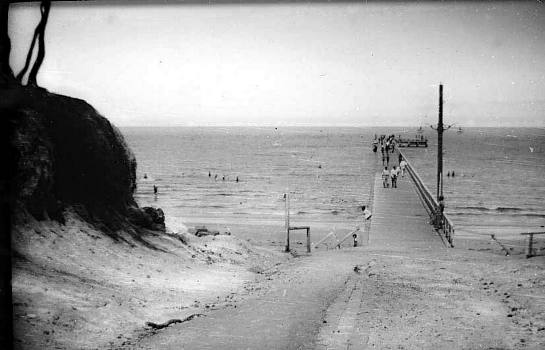
Mentone Pier, 1928. Photograph by Paul Lemmon Courtesy Sheila Johnston.
Leisure activities other than bay tours dominated the six decades of Mentone pier’s existence. Fishing was arguably the most important of these. From its earliest days the pier hosted anglers who would occupy favourite spots around the L-shaped section and places nearby. Here they would sit for hours, occasionally re-baiting and casting lines. Most had a wicker basket for the necessary fishing accessories and they all dressed in suitable attire for the various weather patterns the bay could throw at them. These men, and the occasional woman, were patient and stoic types, content to spend many an hour in quiet contemplation of the sea, and happy with the occasional reward of snapper, whiting or other catches. The pier also served the fishermen who used boats and ventured out to sea. They could pull alongside the jetty at the little landing and offer their catches for sale, a particularly lucrative activity during hot summer days when the pier was mobbed with leisure seekers. Locals who had boatsheds or bathing boxes along the beach near the pier could take advantage of opportunities like this because the pier was an incidental market stall on the way to beaching the boat. It was also near the pier that horses were given their sea swims as part of the race training schedule. The legendary ‘Tracker’ Ross who had a boatshed near the pier used his rowing boat to take each horse into the deeper water where it swam behind the dinghy with ‘Tracker’ hanging on to the rope attached to the horse’s bridle. The Ross family took horses to the beach near the pier for over fifty years, starting around the time of World War 1.
While the fishing folk used the pier all year round the swimmers were generally there in the hot season that straddled both sides of the Christmas holidays. Mentone pier played its part in the arguments over beach culture as the nineteenth century came to a close. At the time there was a prohibition on swimming outside proper baths enclosures as well as a customary taboo against the sexes swimming together. There was also considerable prudery about costumes that could be worn on the beach. The pier played a part in the gradual breaking down of strict beach rules as the new century progressed.
When Mentone pier became a reality in the 1890s it offered opportunities and temptations that had not been available before. During hot summer days the daring swimmer could dive off the landing or the main section into deep water and enjoy the freedom this gave. Young people, mainly males, challenged the rules and as time went on forced change. At the time it was considered imprudent to swim in the open sea for safety reasons but the threat was largely ignored. Open sea bathing was common around 1900 as indicated by this report from the Moorabbin News of January 14 1905:
During the past few days a shark of between nine and ten feet in length has been disporting itself off the local pier. Those in the habit of taking their morning dip should keep a sharp lookout, for these creatures sometimes venture into shallow water.
The report seems to indicate a wide disobedience of the law about open sea swimming and by 1911 Moorabbin Shire designated parts of the beach at a fair distance from the official baths enclosures where people could swim. One wonders whether the attempt to discourage open-sea swimming was at least partly due to the fact that local baths proprietors needed paying customers and the baths themselves were on a public foreshore and the ultimate responsibility of the authorities.
At the time there were alternating sessions for males and females to swim in the baths, as it was considered in some way immoral for the sexes to be together in bathing costumes. This applied at least until the time of the Great War, but it broke down during the 1920s. Through the early decades of the twentieth century the thrill of swimming off the Mentone pier helped to challenge the restrictive swimming barriers. Men and boys openly swam around the pier and young women of adventurous spirit did not want to be left out. A few joined in. The custom of segregated swimming was challenged and during the twenties it died.
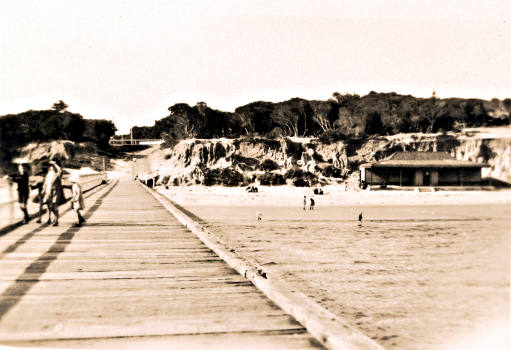
The pier with Mentone Life Saving Club to the right, c1920. Courtesy Gwen Dennis.
The matter of bathing costumes also caused debate and indignation. From Victorian times there was a custom enshrined in council by-laws that the swimming costume had to cover the body from neck to knee. Further to this, local by-laws of Moorabbin Shire stated that a swimmer needed to walk in a straight line from the water over the sand and then put on covering clothes or enter a bathing box or dressing shed. It was illegal to linger on the beach in a bathing costume. This incredibly strict rule was widely breached and led to many letters to the local press and occasional attempts to police it. In 1913 two men were fined for sitting on Mentone beach in swimming costumes and others had been reported to be ‘sunning themselves in tight-fitting garments on Mentone pier in a state of semi-torpor’. The existence of Mentone pier helped to make the by-law on this matter hard to manage. It was so easy to dive off the pier, have a quick swim, and then remain there in bathers. Did the authorities really expect a swimmer to walk the length of the pier back to a change room after every swim on a hot day? It was against the law to dive off the pier anyway, so the daredevils were hardly likely to obey costume regulations. There was a noticeboard near the pier’ s landing informing people that diving was an offence but it only served as a challenge to many of the young locals. One rose in status among the peer group by climbing on to the noticeboard for a high dive into the sea. It would have been impossible to have police or inspectors on the end of the pier all day, so the swimmers generally ignored the restrictions. Young men developed competitions that involved running at full speed along the L-shaped section of the pier and trying to dive further out to sea than their competitors. Many scared the daylights out of observers when they nearly landed on top of one another. The beach laws were totally ignored. Different attitudes in the 1920s saw these laws lapse.
Throughout the first half of the twentieth century and for a few years beyond the Mentone pier provided a stage for countless hours of simple pleasure. Apart from the swimmers, fishers and boaters, there were thousands who enjoyed the passive recreation it allowed. A visit to the beach was not complete without a stroll along the promenade that was constructed behind the sea wall, built with ‘susso’ labour between the baths and the pier during the 1930s. It was customary for most people to walk to the end of the pier and watch the anglers and the antics of the young swimmers before returning to the beach. The pier also provided a place for young lovers to take a stroll, for old timers to wistfully stare at the waves, or for families to add a little adventure to the picnic day. It gave the local beach some character. Mentone people usually defined their going to the beach by saying ‘We’ll be down at the pier’, or We’re going to the baths’.
Mentone pier also provided an impromptu grandstand for the life-saving club carnivals on the sands nearby. Mentone Life-Saving Club had its two-storey timber pavilion near the pier after its construction in 1928. Periodically through the next few decades there would be beach carnivals in front of this clubhouse where the bayside clubs competed in life-saving skills, particularly the reel and line event in which teams competed in executing the fastest rescue of a ‘drowning’ swimmer out some distance in the sea. The rescuer had a line attached and the reel operators would wind him or her back to shore with the victim held safely in front. Scores of spectators lined the shore end of the pier to watch this and other events. The carnival highlight was the march past of all the teams clad in their bright costumes of club colours. Great rivalry made these contests important for club members, especially as the competitors included neighbouring clubs such as Mordialloc, Parkdale, Chelsea, Black Rock and Edithvale. Mentone won its share of competitions and the applause from the pier vantage-point was generous.
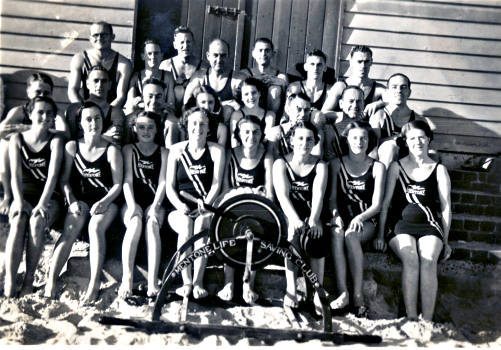
Members of the Mentone Life Saving Club outside their club house adjacent to the pier, c1940. Courtesy Mordialloc and District Historical Society.
Unhappy events were rare at Mentone pier, for it was a place designed to provide episodes of enjoyment. There were, however, some tragedies. People got into difficulties swimming and some drownings occurred. Ron Lister, who was a young lad in the 1920s, remembers a schoolmate from Mentone Primary School losing his life when he could not make it back to the pier during a swimming session at that time.
One aspect of the pier that caused much disapproval was the huge outlet pipe that ran under the shore end for a short distance into the sea. This pipe took storm water into the bay but in the middle part of last century, before strict environmental laws became a reality, other materials flowed into the sea as well. There was always a smell of tar or other gas works odours around the pier’s shallow end, and often there would be brown sludge in the water close to the sand. It seems that residues from the Mentone Gas Works in Brindisi Street found their way into the sea underneath the pier and made the area near there unpleasant for swimmers. This was a fact of life before the gas industry closed the works after the 1954 takeover by the Gas and Fuel Corporation located in Highett.
During World War 2 members of the Home Guard were called to the Mentone pier one day when sharks were noticed swimming near the structure. Witnesses record that the men fired .303 rifles at the sea creatures sending bullets ricocheting across the water out to sea. The sharks apparently were undisturbed and perhaps a little bemused by all the noise.
The demise of the pier came in the 1960s. Over the life of the structure much money had to be spent to repair the constant wear and tear wrought by the elements. Storms brought waves that lashed the timbers and over time metal bolts rusted in the salty air. Replacement of planks and other woodwork became more and more frequent and costly as the pier aged. In the late 1950s the State Government showed a growing reluctance to make the repairs and concerns were raised at Mordialloc Council that the pier was unsafe. By 1959 the matter came to a head. Rumours began circulating that the pier would be demolished and in March of that year Sir Thomas Maltby, the Minister of Public Works, came to Mentone. With E R Meagher, MLA, W P Mair, MLC, Cr Hawken, Mordialloc Mayor, Jack Grut, Town Clerk and Walter Galt, City Engineer, he inspected the pier and declared that it should be demolished in the interests of public safety. There then began a period of several years where residents attempted to save the pier and arguments raged as to the feasibility of various schemes suggested.
A ‘Save The Pier’ group was formed and meetings were held in mid-1959. A suggestion that the pier be made into a breakwater by filling in the gaps between the piles with concrete was popular but eventually rejected by the government. The whole issue boiled down to cost. Maltby stated that it would cost 40,000 pounds to repair the pier and only 2,500 pounds to demolish it. To erect a new one would cost 53,000 pounds. Local politicians such as Meagher promised to lobby for funds to build a new pier but their efforts were in vain. Piers at Elwood and Brighton were being demolished at the time, and, in view of promises to retain the Mordialloc pier, it was unlikely that Mentone’s could be saved as well.
At the ‘Save The Pier’ meeting in July 1959 Ralph Sierakowski, a prominent local hotelier and Mentone resident, moved that the demolition be delayed for a year while talks went on. This motion was carried and eventually agreed to by Minister Maltby. Many local people then formed a ‘Mentone Pier Retention Committee’ and this body tried to exert political pressure for their cause. At the time the whole matter of the beach erosion and the disappearance of the sand at Mentone was under consideration by the MMBW so the pier controversy became part of that issue as well. The pier support group tried to get the MMBW to include the pier in the plans that involved beach reclamation. They revived the breakwater idea. Ray Meagher, MLA, and the local council succeeded in getting the Government to promise that the pier would remain until funds could be found to build a new one, preferably in concrete. Many different groups were called into the fight. Life-saving clubs, the Mordialloc Motor Yacht Squadron, local business owners and ordinary residents all mounted arguments for the pier to be kept. None of them succeeded. The Government promise not to let the pier go until a new concrete one could be built was not as concrete as the proposed structure and the new pier was never to be built, even though the old one remained there in a state of advancing decay. In 1960 the authorities closed the pier and erected a barrier to prevent entry to it. A large ‘Jetty Closed’ sign went up. None of the efforts to solve the problem was helped by the action of two youths a year or so later.
At 8-40 p.m. on Sunday 1st October 1961, Mentone people were jolted by a loud explosion that was heard as far away as Cheltenham. At least twenty windows along the beachfront were shattered by the blast. Police were called to the pier to discover a large hole had been blown in the decking near the beach end of the structure. Explosives had been used to blast the pier’s woodwork near the ‘Jetty Closed’ barrier. Two youths, one from Cheltenham and the other from Sandringham, were charged with stealing gelignite from Puckapunyal Military Camp and later fined. Their dangerous action did not help the pier’s friends in their campaign, as its derelict condition made it a target of vandals and a threat to public safety.
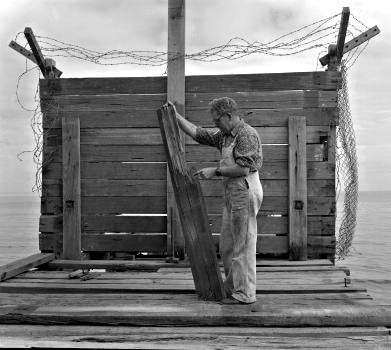
George Broadbent points to the hole in pier decking caused by explosion, 1961. Courtesy Leader Collection.
The pier remained but the reluctant Government support for it gradually waned until inevitably patience ran out. By 1964 it was obvious that the promise to find large sums of money to build a new pier could not be kept. The pier was demolished. For weeks late in 1964 there were loud explosions as the piles were blasted out. Coincidentally the Mentone Baths demolition occurred in that year as well, its ageing structure having been destroyed by fire in mid-1962.

Piles from the demolished Mentone Pier, 1964. Courtesy Leader Collection.
Long-term residents, especially the beach-lovers, missed the pier. They also saw the Mentone beach virtually disappear during the late fifties and through the sixties. This was remedied in the massive restoration program of 1977, but the beach structures were never re-built. Dr Eugene Docherty, a local GP, wrote to the Mordialloc News in 1973 expressing a longing for the Mentone of earlier times and disdain for the modern fast life that people lived. One of his points was that the pier was a Mentone icon when he had come here from Scotland. It had provided a place for people to fish, to stroll and to contemplate; it aided mental health. He regretted its demise. Someone wrote to the paper and said he was living in the past. But later on there were others who agreed with his sentiments and tried to go further than dream about the past.
In 1994 there was a serious attempt to revive interest in re-building the pier. Cr Ian McPherson, a member of the Mordialloc Council that was about to be amalgamated into the new identity of Kingston, began a campaign to re-build the pier. Throughout the year he worked hard to interest Council and business owners in supporting the proposal. Rex Hunt, the media fishing expert, added his voice of support at one stage. Council ran a feasibility study and found it would cost at least $600,000 to build a pier. Cr McPherson suggested a campaign whereby business people and residents would buy ‘planks’ and ‘pylons’ for various amounts and have them inscribed with their names. Despite his detailed planning and costing of the project there was not enough material support. Mordialloc’s City Engineer, Tony Rijs, said Council would support a pier project but only if the money was raised outside of Council. At the end of 1994 Mordialloc City Council ceased to exist. Commissioners were appointed to run the new Kingston municipality for two years, and the whole matter of the pier got lost in a myriad of matters concerning the new local government arrangements. Mentone pier remains a distant memory and the likelihood of it ever being re-built seems very small.
